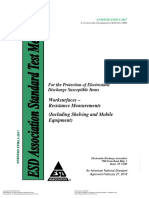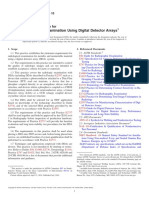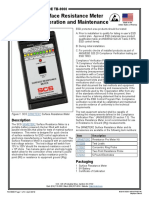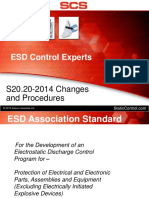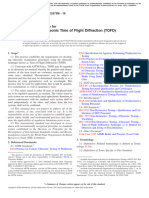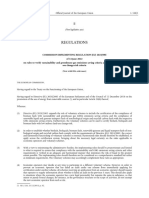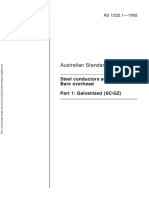Digital Surface Resistance Meter Kit Installation, Operation and Maintenance
Digital Surface Resistance Meter Kit Installation, Operation and Maintenance
Uploaded by
エンリコ エリカCopyright:
Available Formats
Digital Surface Resistance Meter Kit Installation, Operation and Maintenance
Digital Surface Resistance Meter Kit Installation, Operation and Maintenance
Uploaded by
エンリコ エリカOriginal Title
Copyright
Available Formats
Share this document
Did you find this document useful?
Is this content inappropriate?
Copyright:
Available Formats
Digital Surface Resistance Meter Kit Installation, Operation and Maintenance
Digital Surface Resistance Meter Kit Installation, Operation and Maintenance
Uploaded by
エンリコ エリカCopyright:
Available Formats
TECHNICAL BULLETIN TB-3062
Digital Surface Resistance Meter Kit
Installation, Operation and Maintenance Made in the
United States of America
The Surface Resistance Meter Kit (or its Meter) is referenced
and designed to be used to make measurements in
accordance with the test procedures in:
• Compliance Verification - ESD TR53 - Resistance
Measurements
• Worksurfaces - ANSI/ESD S4.1 Worksurfaces
• Floors - ANSI/ESD S7.1- Resistive Characterization of
Materials Floor Materials
• Foot Grounders - ESD SP9.2 - Foot Grounders
Resistive Characterization
• Garments - ANSI/ESD STM2.1 Garments
• Seating - ANSI/ESD STM12.1- Seating - Resistive
Measurement
• Floor/Footwear - ANSI/ESD STM97.1 - Floor Materials
and Footwear- Resistance Measurement in Combination
with a Person
Figure 1. Desco Digital Surface Resistance Meter Kit “A Compliance Verification Plan shall be established
to ensure the Organization’s fulfillment of the technical
Description requirements of the ESD Control Program Plan. Process
monitoring (measurements) shall be conducted in
The Desco 19787 Digital Surface Resistance Meter Kit is accordance with a Compliance Verification Plan that
an instrument designed to measure resistance point-to-point identifies the technical requirements to be verified, the
(Rtt) or surface to ground (Rtg) in accordance with ESD measurement limits and the frequency at which those
Association Standard ANSI/ESD S4.1. verifications shall occur. The Compliance Verification Plan
Its test funcitions include: shall document the test methods and equipment used for
• Resistance measurement accuracy of ±10% process monitoring and measurements. If the test methods
(±20% for resistance values 1 x 1011 and greater) used by the Organization differ from any of the standards
• Resistance range of <1 x 103 ohms to >1 x 1012 ohms referenced in this document, then there must be a tailoring
• Under load voltages of 10 and 100 volts ±5% statement that is documented as part of the ESD Control
• Electrification period of approximately 15 seconds Program Plan. Compliance verification records shall be
established and maintained to provide evidence of conformity
The Digital Surface Resistance Meter also measures ambient to the technical requirements.
temperature and relative humidity. The test equipment selected shall be capable of making the
measurements defined in the Compliance Verification Plan.”
The Digital Surface Resistance Meter Kit and its accessories (ANSI/ESD S20.20 section 7.3)
are available in the following item numbers:
Reference Literature
Item Description In addition to those noted above:
19787 Digital Surface Resistance Meter Kit ANSI/ESD S20.20 - Development of ESD Control Program
ESD ADV1.0 - Glossary of Terms
19788 Digital Surface Resistance Meter
ANSI/ESD S6.1 Grounding
19783 Shielded Test Leads
These documents can be obtained directly from the ESD
50003 Five Pound Electrodes, 1 Pair Association, 7902 Turin Rd., Suite 4, Rome, NY 13440-2069,
50004 Replacement T-Handles for Electrodes, 1 Pair (315) 339-6937 or www.ESDA.org.
50005 Concentric Ring Probe
DESCO WEST - 3651 Walnut Avenue, Chino, CA 91710 • (909) 627-8178
DESCO EAST - One Colgate Way, Canton, MA 02021-1407 • (781) 821-8370 • Website: Desco.com
TB-3062 Page 1 of 8 April 2013 © 2013 DESCO INDUSTRIES, INC.
Employee Owned
Packaging Features and Components
19787 Digital Surface Resistance Meter Kit
1 Digital Surface Resistance Meter A
2 Shielded Test Leads, 5' Length
2 Five Pound Electrodes
2 AA Alkaline Batteries
1 Gator Clip
1 Plastic Carrying Case
1 Certificate of Calibration
B
E F
FRONT VIEW
Figure 2. Desco 19787 Digital Surface Resistance
Meter Kit
19788 Digital Surface Resistance Meter
1 Digital Surface Resistance Meter
2 AA Alkaline Batteries
1 Certificate of Calibration
REAR VIEW
Figure 3. Desco 19788 Digital Surface Resistance Meter Figure 4. Digital Surface Resistance Meter features and
components
DESCO WEST - 3651 Walnut Avenue, Chino, CA 91710 • (909) 627-8178
DESCO EAST - One Colgate Way, Canton, MA 02021-1407 • (781) 821-8370 • Website: Desco.com
TB-3062 Page 2 of 8 © 2013 DESCO INDUSTRIES, INC.
Employee Owned
A. Test Jacks: The shielded test leads connect here. The F. Quick Check Button: When set to FULL, the meter
black test lead’s 3.5mm plug connects into the stereo jack, will cycle through the 15 second period that displays the
and the white test lead’s banana plug connects into the temperature and relative humidity before the surface
banana jack. resistance mantissa is displayed. When set to QUICK, the
meter will skip the 15 second period and immediately display
B. Display: Temperature, Relative Humidity and Surface the measured surface resistance mantissa.
Resistance Mantissa values appear on this display.
G. Test Button: Push and hold this button to make a
When the test button is depressed and the meter is set to measurement with the meter. Testing in accordance with
FULL test mode, the following information will display in ANSI/ESD S4.1 requires 15 seconds of electrification. These
sequence: 15 seconds are included when the meter is set to FULL test
• Temperature in degrees Fahrenheit (±10%) mode. The surface resistance mantissa will display on the
• Temperature in degrees Celsius (±10%) meter after temperature and relative humidity measurements
• Relative Humidity as a percentage (±10 integers) are displayed.
• Surface Resistance Mantissa (with exponent displayed The surface resistance exponent number illuminates
via LED, measurement in ohms) immediately, and the meter first displays the temperature
Surface resistance ohm values are expressed with a and relative humidity during a 15 second electrification
mantissa and exponent (power) of the number. For example, period. The mantissa is then displayed at the end of the test
if the #8 exponent LED illuminates and the meter displays sequence. For example, if the #8 exponent LED illuminates
“7.14”, the measurement is 7.14 x 108 ohms or 714,000,000 and the meter displays “7.14”, the measurement is 7.14 x 108
ohms. ohms or 714,000,000 ohms.
If the measured surface resistance is over 1012 ohms, “1___” H. Battery Compartment: Open this compartment to install
will appear on the display. the two AA alkaline batteries needed to power the meter.
Replace the batteries once the Function LEDs begin flash.
C. Exponent LEDs: These LEDs indicate the surface
resistance exponent value. They are color coded for quick Operation
checks.
General Guidelines
Exponent Color • Use both 5 pound electrodes for Rtt measurements.
<3, 3 Red • Use one 5 pound electrode and connect the black test
lead to ground for Rtg measurements.
4, 5 Green
• Ensure that the item being measured is electrically
6, 7, 8 Blue isolated (placed on an insulative surface). The meter will
9, 10 Green measure the lowest resistance path.
11, 12, >12 Yellow • Ensure that the test leads are separated and uncrossed
as a best practice.
Quick Checks • When using 5 pound electrodes:
The surface resistance exponent number illuminates • Place them no closer than 2" from the edge of the
immediately (i.e. 8 = 108 ohms or 100,000,000 ohms). surface being measured
• Place them no closer than 3" to any groundable
D. Function LEDs: These LEDs indicate the measurement
point
type indicated on the display. The surface resistance
• Place them about 10" apart from each other for Rtt
mantissa is displayed when either the “10V” or “100V” LED is
measurements of a worksurface
illuminated.
• Place them about 3' apart from each other for Rtt
These LEDs will flash when the battery voltage drops to measurement of a floor
approximately 2 volts. Replace the batteries when this • Preferable electrode placements include:
occurs. • Most commonly used area of a surface
E. Test Voltage Button: When set to AUTO, the meter will • Most worn area
automatically switch to the appropriate test voltage for the • Center of surface
measured resistance range. The Function LEDs will indicate • Furthest area from a grounded point
the applied test voltage. Material that is 9 x 105 ohms or • If the surface to be measured has sections (i.e. floor
less should be measured at 10 volts. Material that is 1 x 106 tiles, garment panels), place the 5 pound electrodes on
ohms or greater should be tested at 100 volts. When the different sections for Rtt measurements.
switch is set to 10V HOLD, the test voltage will be fixed at 10 • Clean the material’s surface for Test Lab measurements,
volts regardless of the measured resistance value. but do not clean the surface for materials that are
already installed. Only clean and re-test the installed
material if failure occurs.
DESCO WEST - 3651 Walnut Avenue, Chino, CA 91710 • (909) 627-8178
DESCO EAST - One Colgate Way, Canton, MA 02021-1407 • (781) 821-8370 • Website: Desco.com
TB-3062 Page 3 of 8 © 2013 DESCO INDUSTRIES, INC.
Employee Owned
• Push and hold the Test Button until the surface • Perform additional measurements by placing the
resistance mantissa is displayed. electrode on the most commonly used or worn area. Set
the meter to QUICK test mode to skip the 15 second
Measure Resistance to Ground (Rtg) period if preferred.
Test Procedure in accordance with ANSI/ESD S4.1 section
6.4 Periodic Worksurface Testing: If the measurement is outside acceptable limits, clean the
• Do not clean the surface. surface with an ESD cleaner containing no insulative silicone
• Remove from the surface only those items that might such as Reztore™ Antistatic Surface & Mat Cleaner, and
interfere with the test. re-test to determine if the cause of failure is an insulative dirt
• ESD sensitive devices shall also be removed. layer or the ESD worksurface material.
• Clip the black test lead to a grounded point.
• Use one 5 pound electrode on the other test lead and
place the electrode on the furthest convenient point on
the surface.
• Push and hold the Test Button until the surface 10"
resistance mantissa is displayed.
• Perform additional measurements by placing the
electrode on the most commonly used or worn area. Set
the meter to QUICK test mode to skip the 15 second
period if preferred.
If the measurement is outside acceptable limits, clean the
surface with an ESD cleaner containing no insulative silicone
such as Reztore™ Antistatic Surface & Mat Cleaner, and
re-test to determine if the cause of failure is an insulative dirt
layer or the ESD worksurface material.
Figure 6. Rtt test setup - set the electrodes about 10"
apart for worksurfaces and about 36" apart for flooring
Reporting and Using Test Results
Different standards have different requirements; however,
follow the requirements as specified in the user’s ESD
control plan. Examples are:
Per ANSI/ESD 4.1 (Worksurfaces), report:
• Rtg maximum and minimum values measured for
resistance-to-ground in ohms
• Rtt maximum and minimum values measured for
point-to-point resistance in ohms
Per ANSI/ESD 7.1 (Floors), report:
• Rtg all values in ohms for resistance-to-ground
Figure 5. Rtg test setup • Rtt all values in ohms for point-to-point resistance
• Voltage level
Measure Resistance Point-to-Point (Rtt) on the Surface • Test date
• Do not clean the surface. • Temperature
• Remove from the surface only those items that might • Relative humidity
interfere with the test. • Test equipment used and latest calibration date
• ESD sensitive devices shall also be removed.
• Use two 5 pound electrodes and place them on the most Summarize the test data by reporting the minimum,
commonly used area of the surface. Ensure that the maximum, median and mean values that were obtained.
electrodes are about 10" apart from each other and 2" Include a diagram showing the approximate electrode
away from any edge and 3" away from any grounded positions and ground connections used.
point.
• Push and hold the Test Button until the surface
resistance mantissa is displayed.
• If the most used area is not obvious, use two points near
the center of the surface.
DESCO WEST - 3651 Walnut Avenue, Chino, CA 91710 • (909) 627-8178
DESCO EAST - One Colgate Way, Canton, MA 02021-1407 • (781) 821-8370 • Website: Desco.com
TB-3062 Page 4 of 8 © 2013 DESCO INDUSTRIES, INC.
Employee Owned
Frequency of Compliance Verification Testing Surface Resistivity
NOTE: “The frequency of periodic testing is normally Theoretically, Resistivity is 10 times greater than Resistance.
specified in corporate operating procedures. …The frequency
of testing is driven by the amount of risk exposure that can For example, a material that measures 107 ohms in surface
occur between tests. For, example, what is the quantity of resistance should measure 108 ohms/square in surface
product handled between test periods?” (See ESD Handbook resistivity.*
ESD TR20.20) Ref: ANSI/ESD STM11.11 section 12.0 Conversion to
Per ANNEX A of Compliance Verification ESD TR53 “Test Resistivity states, “When it is appropriate to convert a
Frequency, The objective of the periodic test procedures resistance obtained by this test method to an equivalent
listed in this document is to identify if significant changes in resistivity in ohms per square, multiply the resistance
ESD equipment and materials performance have occurred measurements obtained by this method by 10. The
over time. Test frequency limits are not listed in this conversion factor of 10 is derived from the geometry of the
document, as each user will need to develop their own set electrode assembly.”
of test frequencies based on the critical nature of those ESD *Note: Although STM11.11 uses ohms/square, per ESD
sensitive items handled and the risk of failure for the ESD TR20.20, the correct unit of measure for resistivity is just
protective equipment and materials.” ohms.
Addition information includes:
Product Qualification Test Lab Test Procedure Guideline
• Worksurface - at least quarterly (see ESD TR20.20 For test lab use of ESD Worksurfaces, Floor Materials,
section 5.3.1.13 Periodic Tests) Footwear, Garments or Seating, the best advice is to follow
• Footwear - “Incoming inspection on a lot sampling basis the test methods in applicable ESD Association documents
should be performed for all static control footwear.” (see which include details such as:
ESD TR20.20 section 5.3.3.4 Testing) • Cleaning (For example per S4.1, “The test specimens
• Floor - “The types of monitoring and type of equipment and electrodes shall be cleaned twice with a minimum
are considerations. In some cases, a simple electrical 70% isopropanol-water solution using a clean, low-linting
resistance test with a megohmmeter may suffice. In cloth each time). Allow to the material to dry.
others, a static charge generation test may be required.” • Environmental chamber (For example per S4.1, control
(see ESD TR20.20 section 5.3.4.13 Performance relative humidity to 12 ±3% relative humidity and 50 ±5%
Monitoring) relative humidity and temperature to 23 ±1°C)
• Seating - “The recommended electrical resistance • Specimen support surface (For example per S4.1,
range for seating is less than 1 x 109 ohms as tested in greater than 1 x 1012 ohms such as PMMA, PTFE or
accordance with ANSI/ESD STM 12.1. This value should polycarbonate)
be during acceptance testing, installation and periodically • Specimen Pre-Conditioning (For example per S4.1, at 23
thereafter.” (see ESD TR20.20 section 5.3.5.3 Testing) ±1°C; 3 specimens at 12 ±3% relative humidity for up to
• Garments - “To maintain process control, it is imperative 72 hours minimum, and 3 specimens at 50 ±5% relative
that the garment be tested per ANSI/ESD STM 2.1. The humidity for up to 72 hours minimum)
point-to-point and sleeve-to-sleeve resistance test should • Reporting Test Results: For example per S4.1 Reporting
be made.” (see ESD TR20.20 section 5.3.13.3.1.8 Test Results, report:
Periodic Testing) • Minimum, median and maximum readings for both
resistance-to-groundable point and point-to-point
resistance in ohms at low relative humidity
• Minimum, median and maximum readings for both
resistance-to-groundable point and point-to-point
resistance in ohms at moderate relative humidity
• Temperature
• Relative humidity
• Actual duration of conditioning
• Test equipment used and latest calibration date
DESCO WEST - 3651 Walnut Avenue, Chino, CA 91710 • (909) 627-8178
DESCO EAST - One Colgate Way, Canton, MA 02021-1407 • (781) 821-8370 • Website: Desco.com
TB-3062 Page 5 of 8 © 2013 DESCO INDUSTRIES, INC.
Employee Owned
Desco 50005 Concentric Ring Probe Cleaning the Digital Surface Resistance Meter
The area surrounding the cable jacks at the top end of the
meter should be wiped with a clean, isopropanol-alcohol
moistened cloth to remove skin oils that will accumulate
and affect the meter’s accuracy at high resistances. The
frequency of cleaning will depend on usage. Desco
recommends cleaning this area once a month. Cable jackets
should also be cleaned in this fashion.
Cleaning the Five Pound Electrodes
Per ANSI/ESD S4.1 “Clean the electrodes with a minimum
70% isopropanol-water solution. Make sure the 5 pound
electrodes’ conductive pads are dry prior to use.”
See specific product test standards for test lab specimen
cleaning instructions. Per ANSI/ESD S4.1 Worksurfaces
“The test specimens and electrodes shall be cleaned twice
with a minimum 70% isopropanol-water solution using a
clean, low-linting cloth each time.” (Note: The item should
then be conditioned for 72 hours minimum)
Calibration
Figure 7. Desco 50005 Concentric Ring Probe
The Digital Surface Resistance Meter is calibrated to NIST
The Desco 50005 Concentric Ring Probe is an instrument to traceable standards. Most users require calibration annually
be used in conjunction with a resistance meter, such as the which is our recomendation. Please e-mail
Desco 19787 Digital Surface Resistance Meter, to measure Service@Desco.com for details. In-house calibration can be
surface resistance per ANSI/ESD STM11.11 the test method performed by using 1% resistors in each of the meter ranges.
listed in Packaging standard ANSI/ESD S541 for surface Simply attach the resistors to the test leads using clips and
resistance of planar materials. record the meter’s display. Keep the test leads uncrossed
and separated from one another. Should adjustment be
The Concentric Ring Probe (Ref: ANSI/ESD STM11.12) can necessary, Desco recommends to return the unit to the
measure the volume resistance of planar materials using a factory. Special equipment is required to adjust the meter.
flat conductive metal plate (not included).
Required Equipment
The Concentric Ring Probe may be used for the resistance • Digital Multimeter: accurate to 1.25% @ 10VDC and
measurements of ESD packaging including static shielding 100VDC
and other bags. • Fixed Decade Box with values from 103 - 1012:
accurate to ±2%, except at 1011 and 1012 (±5%)
See TB-3063 for more information. • Thermometer: accurate to ±1°F
• Relative Humidity Meter: accurate to 2%
Maintenance • Test Leads
The Digital Surface Resistance Meter requires little • 99% Isopropyl Alcohol and Cleaning Wipes
maintenance. There are no user serviceable parts. If your Setup
meter requires service beyond cleaning the electrodes or • Test Area - needs to be free of any high voltage
replacing the batteries, please contact the factory. transformers or power supplies and away from any type
This product utilizes a high frequency switching circuit to step of fluorescent lighting or high power lighting.
up the 3 volts from the batteries to the 100 volt test level. • Worksurface - needs to be covered with a grounded
Some users are able to discern a slight hum or buzzing when conductive mat at 1.0 x 103 or less.
the meter is powered. This is perfectly normal and is not
• Technician - needs to be connected to equipment
considered a flaw or defect.
ground with a 0 ohm resistor in the ground cord.
Battery Replacement • Decade Box - needs to be connected to equipment
The Function LEDs located above the push buttons will flash ground.
when the battery voltage drops to approximately 2 volts.
This indicates that the meter’s batteries should be replaced.
Open the compartment located on the back of the meter
to replace the batteries. The meter uses two AA alkaline
batteries. Ensure that the batteries’ polarities are oriented in
the correct fashion to avoid any possible circuit damage.
DESCO WEST - 3651 Walnut Avenue, Chino, CA 91710 • (909) 627-8178
DESCO EAST - One Colgate Way, Canton, MA 02021-1407 • (781) 821-8370 • Website: Desco.com
TB-3062 Page 6 of 8 © 2013 DESCO INDUSTRIES, INC.
Employee Owned
Normalization of the Meter
The temperature inside the testing area needs to be 75°F F. 1.0 x 107
±3°F at 40% to 60% relative humidity. The meter needs +10% LED = 7 Blue Mantissa 1.10
to stay at a temperature of 75°F ±3°F for approximately 2 0% LED = 7 Blue Mantissa 1.00
hours for proper readings. The meter cannot be normalized -10% LED = 6 Blue Mantissa 9.00
inside objects, enclosed boxes, containers or cases. The
temperature inside an enclosed case will differ from the G. 1.0 x 106
outside temperature. These cases will act as insulators to +10% LED = 6 Blue Mantissa 1.10
the meter. The meter must remain stationary in the testing 0% LED = 6 Blue Mantissa 1.00
area for about 2 hours without any significant changes to the -10% LED = 5 Green Mantissa 9.00
temperature. H. 1.0 x 105
NOTE: Accuracy is measured after normalizing the meter for +10% LED = 5 Green Mantissa 1.10
a minimum of 2 hours. 0% LED = 5 Green Mantissa 1.00
-10% LED = 4 Green Mantissa 9.00
Calibration Test Procedure I. 1.0 x 104
• Use only the test leads that were supplied with the +10% LED = 4 Green Mantissa 1.10
meter. 0% LED = 4 Green Mantissa 1.00
• Clean around the banana jack and stereo jack located at -10% LED = 3 Red Mantissa 9.00
the top of the meter with 99% isopropyl alcohol. Oil from
J. 1.0 x 103
human fingers can affect the accuracy of the meter.
+10% LED = 3 Red Mantissa 1.10
• Set the Test Voltage Button to 10V HOLD. Press and 0% LED = 3 Red Mantissa 1.00
hold the Test Button. The measured voltage between -10% LED = <3 Red Mantissa <0.90
the two test leads should be 10V ±5%.
• Set the Test Voltage Button to AUTO. Press and hold Specifications
the Test Button. The measured voltage between the two Resistance Ranges 1 x 103 - 1 x 1012 ohms @ 10 Volts,
test leads should be 100V ±5%. complies with ANSI/ESD S4.1
• Ensure that the Test Voltage Button is set to AUTO 1 x 106 - 1 x 1012 ohms @ 100 Volts,
when performing the following measurements. Always complies with ANSI/ESD S4.1
measure from 1.0 x 1012 ohms and work your way down
to 1.0 x 103. Never start your measurements from 1.0 x Accuracy Resistance measurements within
103. ±10% (±20% for resistance values
1 x 1011 and greater), complies with
Temperature: 75°F ±3°F (23.9°C ±1.7°C) ANSI/ESD-S4.1. Under load
Relative Humidity: ±10 digits voltages of 10 Volts ± 5% and 100
Volts ± 5% exceeds requirements
A. 1.0 x 1012 of ANSI/ESD S4.1
+20% LED = 12 Yellow Mantissa 1.20 Power Supply 2 AA alkaline batteries
0% LED = 12 Yellow Mantissa 1.00
-20% LED = 11 Yellow Mantissa 8.00 Battery Life Approx. 1,500 measurements
11
B. 1.0 x 10 Operating Temperature 32°F - 104°F (0 - 40°C)
+20% LED = 11 Yellow Mantissa 1.20
0% LED = 11 Yellow Mantissa 1.00 Meter Dimensions 8.1" x 4.1" x 1.5"
-20% LED = 10 Green Mantissa 8.00 (20.6cm x 10.4cm x 3.8cm)
C. 1.0 x 1010 Meter Weight 0.7 lbs (0.3 kg)
+10% LED = 10 Green Mantissa 1.10 Kit Dimensions 13.5" x 10.8" x 4.0"
0% LED = 10 Green Mantissa 1.00 (34.3cm x 27.4cm x 10.2cm)
-10% LED = 9 Green Mantissa 9.00
Kit Weight 13.0 lbs (5.9 kg)
D. 1.0 x 109
+10% LED = 9 Green Mantissa 1.10 External Electrode 5 lbs (±2 oz), 2.5" in diameter,
0% LED = 9 Green Mantissa 1.00 complies with ANSI/ESD S4.1
-10% LED = 8 Blue Mantissa 9.00
E. 1.0 x 108
+10% LED = 8 Blue Mantissa 1.10
0% LED = 8 Blue Mantissa 1.00
-10% LED = 7 Blue Mantissa 9.00
DESCO WEST - 3651 Walnut Avenue, Chino, CA 91710 • (909) 627-8178
DESCO EAST - One Colgate Way, Canton, MA 02021-1407 • (781) 821-8370 • Website: Desco.com
TB-3062 Page 7 of 8 © 2013 DESCO INDUSTRIES, INC.
Employee Owned
Limited Warranty
Desco expressly warrants that for a period of one (1) year from the date of purchase Desco Surface Resistance Meters will be free of defects in material
(parts) and workmanship (labor). Within the warranty period, a credit for purchase of replacement Desco Surface Resistance Meters, or, at Desco’s
option, the Surface Resistance Meter will be repaired or replaced free of charge. If product credit is issued, the amount will be calculated by multiplying
the unused portion of the expected one year life times the original unit purchase price. Call our Customer Service Department at 909-627-8178 (Chino,
CA) or 781-821-8370 (Canton, MA) for a Return Material Authorization (RMA) and proper shipping instructions and address. Please include a copy of
your original packing slip, invoice, or other proof of date of purchase. Any unit under warranty should be shipped prepaid to the Desco factory. Warranty
replacements will take approximately two weeks.
If your unit is out of warranty, call our Customer Service Department at 909-627-8178 (Chino, CA) or 781-821-8370 (Canton, MA) for a Return Material
Authorization (RMA) and proper shipping instructions and address. Desco will quote repair charges necessary to bring your unit up to factory standards.
Warranty Exclusions
THE FOREGOING EXPRESS WARRANTY IS MADE IN LIEU OF ALL OTHER PRODUCT WARRANTIES, EXPRESSED AND IMPLIED, INCLUDING
MERCHANTABILITY AND FITNESS FOR A PARTICULAR PURPOSE WHICH ARE SPECIFICALLY DISCLAIMED. The express warranty will not apply to
defects or damage due to accidents, neglect, misuse, alterations, operator error, or failure to properly maintain, clean or repair products.
Limit of Liability
In no event will Desco or any seller be responsible or liable for any injury, loss or damage, direct or consequential, arising out of the use of or the
inability to use the product. Before using, users shall determine the suitability of the product for their intended use, and users assume all risk and liability
whatsoever in connection therewith.
DESCO WEST - 3651 Walnut Avenue, Chino, CA 91710 • (909) 627-8178
DESCO EAST - One Colgate Way, Canton, MA 02021-1407 • (781) 821-8370 • Website: Desco.com
TB-3062 Page 8 of 8 © 2013 DESCO INDUSTRIES, INC.
Employee Owned
You might also like
- Ansi Esd STM4-1 (2017)Document23 pagesAnsi Esd STM4-1 (2017)shawn Akers100% (7)
- ASTM E2698-10 Radiografia Digital DDADocument9 pagesASTM E2698-10 Radiografia Digital DDAaasdassadasasdNo ratings yet
- Astm D4633 PDFDocument7 pagesAstm D4633 PDFwafikmh4100% (2)
- ASTM E2737-10 Standard Practice For Digital Detector Array Performance Evaluation and Long-Term StabilityDocument19 pagesASTM E2737-10 Standard Practice For Digital Detector Array Performance Evaluation and Long-Term StabilitydaiweijueNo ratings yet
- Astm E2192-13Document23 pagesAstm E2192-13Stephen LewellenNo ratings yet
- Week 2-3-PracticalDocument6 pagesWeek 2-3-Practicalエンリコ エリカNo ratings yet
- TB-3062 Surface Resistance TesterDocument8 pagesTB-3062 Surface Resistance Testerrobert_rjcNo ratings yet
- tb-3014-474500 Surface Resistance TesterDocument8 pagestb-3014-474500 Surface Resistance TesterHafiani HichamNo ratings yet
- SRMETER2 Surface Resistance Meter Installation, Operation and MaintenanceDocument4 pagesSRMETER2 Surface Resistance Meter Installation, Operation and MaintenanceGift NkwochaNo ratings yet
- Actual Static Control Market Situation and How To Choose Suitable ESD Flooring Systems For ESD Control Working AreasDocument8 pagesActual Static Control Market Situation and How To Choose Suitable ESD Flooring Systems For ESD Control Working Areastl x100% (1)
- SCS Final S20.20 2015Document37 pagesSCS Final S20.20 2015loncoihaynguNo ratings yet
- TB-3041 Information ESDDocument6 pagesTB-3041 Information ESDAchraf BouraNo ratings yet
- ESD Control Overview: Marcellus Proctor & David Perry Code 562 Lunch & Learn Presentation May 18, 2005Document36 pagesESD Control Overview: Marcellus Proctor & David Perry Code 562 Lunch & Learn Presentation May 18, 2005Swapnil RathodNo ratings yet
- TB 6582Document35 pagesTB 6582Ahmed MijwilNo ratings yet
- TB-3090Document7 pagesTB-309019870000No ratings yet
- Astm E1932 12 2022Document3 pagesAstm E1932 12 2022Mohamed AboelkhierNo ratings yet
- Previews 2206113 PreDocument8 pagesPreviews 2206113 PreServandoNo ratings yet
- ESD-Standards ListDocument4 pagesESD-Standards Listtl xNo ratings yet
- RT-1000 ManualDocument55 pagesRT-1000 Manual19870000No ratings yet
- Eudoc2007 06 07Document23 pagesEudoc2007 06 07Fernando Rodrigues BarcellosNo ratings yet
- Transducers, Pressure and Differential, Pressure, Electrical and Fiber-OpticDocument31 pagesTransducers, Pressure and Differential, Pressure, Electrical and Fiber-OpticEduardoNo ratings yet
- This Datasheet Is Presented by The Manufacturer Dieses Datenblatt Wird Vom Hersteller Bereitgestellt Cette Fiche Technique Est Présentée Par Le FabricantDocument7 pagesThis Datasheet Is Presented by The Manufacturer Dieses Datenblatt Wird Vom Hersteller Bereitgestellt Cette Fiche Technique Est Présentée Par Le FabricantAriv SaputraNo ratings yet
- Katalog Erico System 1000Document12 pagesKatalog Erico System 1000mei pNo ratings yet
- D 5720-95Document9 pagesD 5720-95ipkm123No ratings yet
- Onyx ESD Supplemental DatasheetDocument3 pagesOnyx ESD Supplemental DatasheetAntonio BermudezNo ratings yet
- Esd Audit Scope Esdt-As-001Document15 pagesEsd Audit Scope Esdt-As-001Thayane Lisboa RiosNo ratings yet
- Data Acquisition in Mechanical Testing of Materials and It's ComponentsDocument19 pagesData Acquisition in Mechanical Testing of Materials and It's ComponentsMuhammad FahadNo ratings yet
- NASA HDK 8739.21 Overview 021611Document49 pagesNASA HDK 8739.21 Overview 021611Allan RosenNo ratings yet
- Es D Control Program PeriodicDocument8 pagesEs D Control Program Periodicgowtham raju buttiNo ratings yet
- E1932 - 12. Standard Guide For Acoustic Emission Examination of Small PartsDocument5 pagesE1932 - 12. Standard Guide For Acoustic Emission Examination of Small PartsVíctor JiménezNo ratings yet
- Electrical Equipment Risk Assessment: BackgroundDocument6 pagesElectrical Equipment Risk Assessment: BackgroundMOHAMEDNo ratings yet
- 2023 Online Course CatalogDocument20 pages2023 Online Course CatalogagercodNo ratings yet
- Esd Protection Design Guide: Tvs Diode Arrays: ©2012 Littelfuse, Inc 1Document47 pagesEsd Protection Design Guide: Tvs Diode Arrays: ©2012 Littelfuse, Inc 1Aditya SrivatsavNo ratings yet
- Static Calibration of Electronic Transducer-Based PressureDocument9 pagesStatic Calibration of Electronic Transducer-Based PressureJose Luis Nava HernandezNo ratings yet
- Revisions Symbol Description Date Approval: All Sheets Are The Same RevisionDocument18 pagesRevisions Symbol Description Date Approval: All Sheets Are The Same RevisionjsadachiNo ratings yet
- Study Application Strain Measuring Technology Board Level Assembly Process SmtaDocument6 pagesStudy Application Strain Measuring Technology Board Level Assembly Process Smtabhf_86No ratings yet
- Astm E2373 E2373m 19Document6 pagesAstm E2373 E2373m 19Mohamed AboelkhierNo ratings yet
- Fundamentals of Electrostatic Discharge - : Part Three Basic ESD Control Procedures and MaterialsDocument11 pagesFundamentals of Electrostatic Discharge - : Part Three Basic ESD Control Procedures and MaterialsVan Souza100% (1)
- Revisions Symbol Description Date Approval: All Sheets Are The Same RevisionDocument18 pagesRevisions Symbol Description Date Approval: All Sheets Are The Same Revisionketab_doostNo ratings yet
- Vibration Criterion CurveDocument12 pagesVibration Criterion Curveruleslb4304No ratings yet
- ESD KontrolaDocument8 pagesESD KontrolaLane MedaNo ratings yet
- Examination of Carbon Steel Welds Using Eddy Current Array: Standard Practice ForDocument5 pagesExamination of Carbon Steel Welds Using Eddy Current Array: Standard Practice ForVibratech ENDNo ratings yet
- Astm-E-2373e2373m-14 TofdDocument13 pagesAstm-E-2373e2373m-14 TofdmajidNo ratings yet
- E1932-12 Standard Guide For Acoustic Emission Examination of Small PartsDocument5 pagesE1932-12 Standard Guide For Acoustic Emission Examination of Small PartsDILEEP KUMARNo ratings yet
- 9972 CertificateDocument2 pages9972 Certificatesmallik3No ratings yet
- S TR Earth Lightning Gen (Rev.0 2009)Document6 pagesS TR Earth Lightning Gen (Rev.0 2009)Abhinav SinhaNo ratings yet
- Digital Data Acquisition in Wear and Friction Measurements: Standard Guide ForDocument3 pagesDigital Data Acquisition in Wear and Friction Measurements: Standard Guide ForNav TalukdarNo ratings yet
- E2192-13 Guía Estándar para Dimensionamiento de Altura Plana de Defectos Por UltrasonidosDocument23 pagesE2192-13 Guía Estándar para Dimensionamiento de Altura Plana de Defectos Por Ultrasonidosfredy lopezNo ratings yet
- Measurement of Surface Roughness of Abrasive Blast Cleaned Metal Surfaces Using A Portable Stylus InstrumentDocument6 pagesMeasurement of Surface Roughness of Abrasive Blast Cleaned Metal Surfaces Using A Portable Stylus InstrumentGabriela InfanteNo ratings yet
- EOS/ESD in IC Manufacturing Process of GQFN 64L Devices: Bernard Chin (1), L.H. KohDocument5 pagesEOS/ESD in IC Manufacturing Process of GQFN 64L Devices: Bernard Chin (1), L.H. KohNguyen Van ToanNo ratings yet
- Characterization of Coatings Using Conformable Eddy Current Sensors Without Coating Reference StandardsDocument9 pagesCharacterization of Coatings Using Conformable Eddy Current Sensors Without Coating Reference StandardsDagi GossayeNo ratings yet
- Gordon SPIE99Document12 pagesGordon SPIE99jservosaNo ratings yet
- Astm E2192 13 2022Document11 pagesAstm E2192 13 2022Mohamed AboelkhierNo ratings yet
- Jedec EsdDocument30 pagesJedec EsdRenéNo ratings yet
- Standard ESD EN61340 5 1Document5 pagesStandard ESD EN61340 5 1aurel_c12-1No ratings yet
- Astm F855 20Document7 pagesAstm F855 20Ketan GunjalNo ratings yet
- D5720 Calibracion Estatica de Transductores Basados en PresiDocument9 pagesD5720 Calibracion Estatica de Transductores Basados en PresiEdgar RochaNo ratings yet
- Ecotile ESD Training PresentationDocument28 pagesEcotile ESD Training PresentationNurdianAsri100% (1)
- Design and Implementation of Portable Impedance AnalyzersFrom EverandDesign and Implementation of Portable Impedance AnalyzersNo ratings yet
- On-Chip Electro-Static Discharge (ESD) Protection for Radio-Frequency Integrated CircuitsFrom EverandOn-Chip Electro-Static Discharge (ESD) Protection for Radio-Frequency Integrated CircuitsNo ratings yet
- With Optional Embedded Ethernet Connectivity: Cs8DptDocument3 pagesWith Optional Embedded Ethernet Connectivity: Cs8Dptエンリコ エリカNo ratings yet
- TESA-hite 400 / 700: Instruction ManualDocument52 pagesTESA-hite 400 / 700: Instruction Manualエンリコ エリカNo ratings yet
- Calibration Report of Hach Lange DR 2800 Spectrophotometer: System ChecksDocument6 pagesCalibration Report of Hach Lange DR 2800 Spectrophotometer: System Checksエンリコ エリカNo ratings yet
- LK2678BXDocument2 pagesLK2678BXエンリコ エリカNo ratings yet
- Com-Power Lin-115A Line Impedance Stabilization Network: Insertion LossDocument2 pagesCom-Power Lin-115A Line Impedance Stabilization Network: Insertion Lossエンリコ エリカNo ratings yet
- PCAN-Diag 2: User ManualDocument111 pagesPCAN-Diag 2: User Manualエンリコ エリカNo ratings yet
- AG5 Manufacturing Skills Matrix Template ENDocument12 pagesAG5 Manufacturing Skills Matrix Template ENMarie Emmanuelle AkaNo ratings yet
- Regulation EC 2022 - 996 - On VS Low iLUCDocument62 pagesRegulation EC 2022 - 996 - On VS Low iLUCliliacul2000No ratings yet
- NABIC+Safety ValveDocument58 pagesNABIC+Safety Valvept tabNo ratings yet
- Bixlon SRP 350ii MannualDocument42 pagesBixlon SRP 350ii MannualRIZWAN SHAHNo ratings yet
- NFPA-RF Development Fire Mitigation SolutionsDocument55 pagesNFPA-RF Development Fire Mitigation SolutionsJOSE LUIS FALCON CHAVEZNo ratings yet
- 11 CH 01Document53 pages11 CH 01Zulaikha ZubirNo ratings yet
- Soumya Ud CV MDocument3 pagesSoumya Ud CV MSoumyaranjan BeheraNo ratings yet
- Skoda Octavia 3 Axles Steering EngDocument313 pagesSkoda Octavia 3 Axles Steering EngСергій Латайчук100% (1)
- Guideline On Mahindra Part Approval Process: (For Bought-Out Parts)Document21 pagesGuideline On Mahindra Part Approval Process: (For Bought-Out Parts)Sam AnuNo ratings yet
- Deployment Guide - Provance IT Asset Management Pack PDFDocument24 pagesDeployment Guide - Provance IT Asset Management Pack PDFdebajyotiguhaNo ratings yet
- MFR Nara - t8 - Ansi - Ansi Briefing - 4-29-04 - 00022Document49 pagesMFR Nara - t8 - Ansi - Ansi Briefing - 4-29-04 - 000229/11 Document ArchiveNo ratings yet
- Saes Z 020Document13 pagesSaes Z 020saleem naheedNo ratings yet
- Computer Fundamentals: I P I TDocument50 pagesComputer Fundamentals: I P I TsolomonNo ratings yet
- Dell Insprion 17R (N7010) (Quanta UM9B-C) PDFDocument51 pagesDell Insprion 17R (N7010) (Quanta UM9B-C) PDFGabriel ZănoagăNo ratings yet
- Viscosity Cup PDFDocument16 pagesViscosity Cup PDFSaut Maruli Tua SamosirNo ratings yet
- Saes B 061Document4 pagesSaes B 061SIVANo ratings yet
- InSite Hardness and Crack TesterDocument4 pagesInSite Hardness and Crack TestercarlosNo ratings yet
- Latest Tender Booklet SWR 02.01.2020 Version 9Document86 pagesLatest Tender Booklet SWR 02.01.2020 Version 9ManojNo ratings yet
- MSS SP-25-1998 Standard Marking System For Valves, Fittings, Flanges and Unions PDFDocument29 pagesMSS SP-25-1998 Standard Marking System For Valves, Fittings, Flanges and Unions PDFArmando Lujan VelazquezNo ratings yet
- Mike Ormsby ResumeDocument4 pagesMike Ormsby Resumemichaelormsby100% (3)
- As 1222.1-1992 Steel Conductors and Stays - Bare Overhead Galvanized (SC GZ)Document7 pagesAs 1222.1-1992 Steel Conductors and Stays - Bare Overhead Galvanized (SC GZ)SAI Global - APAC0% (1)
- ICAS Network License ConfigurationDocument5 pagesICAS Network License ConfigurationTarunNo ratings yet
- Interfacing The Arduino With Matlab UsingDocument2 pagesInterfacing The Arduino With Matlab UsingSingam SridharNo ratings yet
- B2020-TDC-VF-009 Vessel Fabrication R0Document5 pagesB2020-TDC-VF-009 Vessel Fabrication R0Ramalingam Prabhakaran100% (1)
- MAY LED Strip Light Quotation-GMDocument3 pagesMAY LED Strip Light Quotation-GMLakmal GayanNo ratings yet
- Congressional Anti Piracy Caucus 2012 Country Watch ListDocument3 pagesCongressional Anti Piracy Caucus 2012 Country Watch Listboland5343No ratings yet
- Performance Qualification Protocol For Vertical AutoclaveDocument22 pagesPerformance Qualification Protocol For Vertical AutoclaveflorNo ratings yet
- Phased Array Ultrasonic Technique Speeds Up Examination of Aluminothermic Rail WeldsDocument1 pagePhased Array Ultrasonic Technique Speeds Up Examination of Aluminothermic Rail Weldscal2_uniNo ratings yet
- Tech Brief For CTI Testing 1016Document4 pagesTech Brief For CTI Testing 1016MuthuswamyNo ratings yet
- VLSI Design NOV 19Document2 pagesVLSI Design NOV 19Saurabh BhiseNo ratings yet
